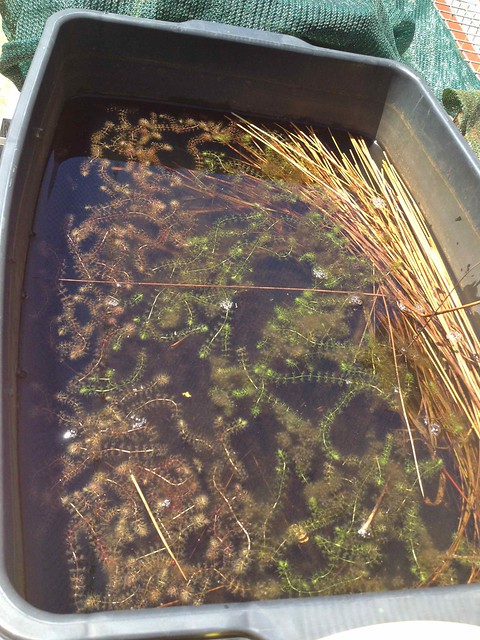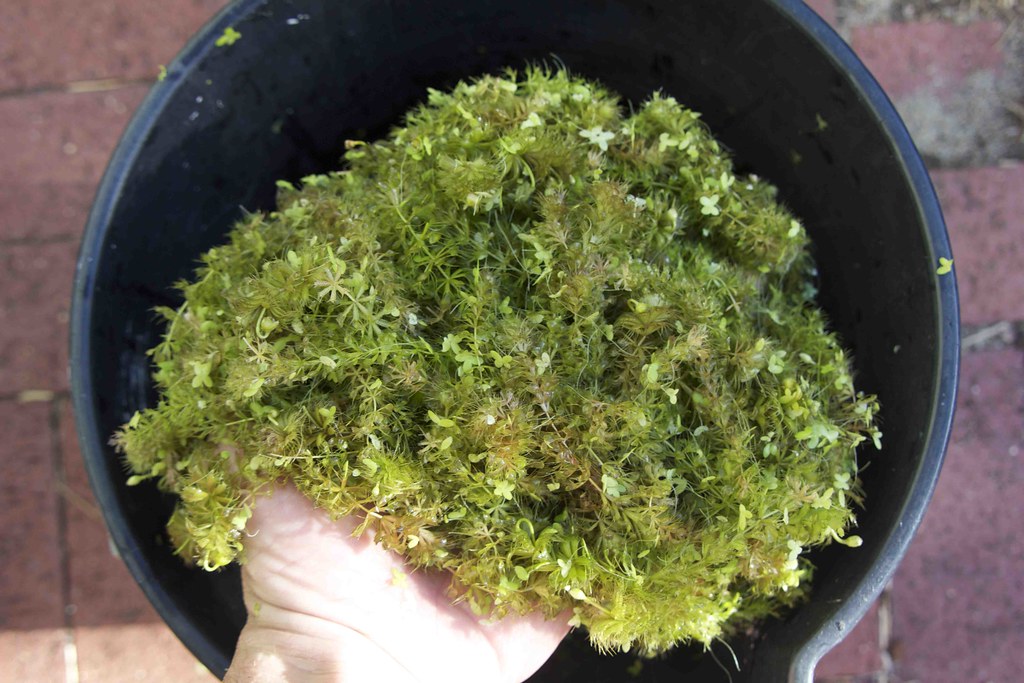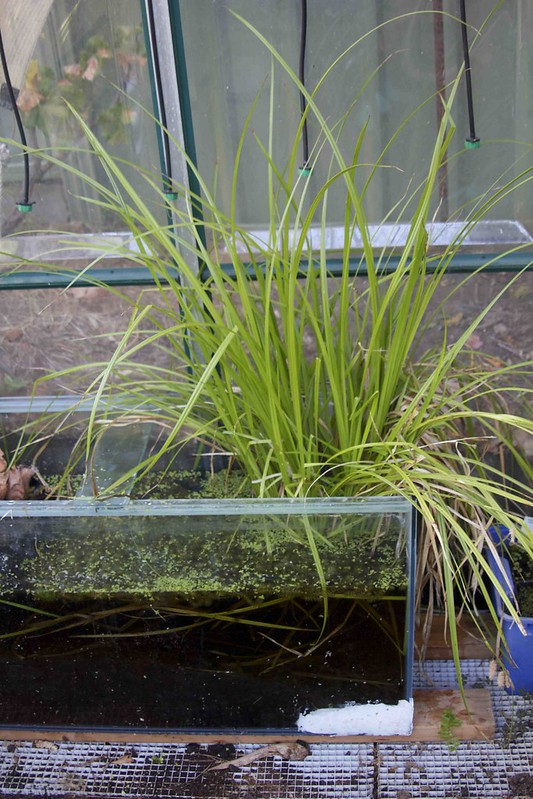|
|
Post by adamcross on Nov 26, 2012 8:43:56 GMT
Here are a few early season photos from several of my A. vesiculosa tanks (apologies for poor quality), the plants having recently begun regrowth after winter dormancy (Perth, Western Australia).    I maintain populations of strains from around the world, last year numbering around 9,000 plants in outdoor culture and around 600,000 in vitro. Most of these images are from simple tanks around 20-30 cm depth with a shallow substrate of composted pine bark and dried Juncus, Carex and Beaumea leaves. The plants look a little scrappy as it's early in the season, but should begin flowering and hit full growth over the next few weeks. I'm very interested in hearing about the cultivation conditions employed by other growers, especially any particularly strange methods that people have had success with- is anyone keen to share? Adam |
|
coline
Full Member
Life's essence: patience
Posts: 484 
|
Post by coline on Jan 6, 2013 22:57:18 GMT
Nice post! I've been interested on the plant, but not have had it still!
|
|
|
|
Post by adamcross on Feb 25, 2013 11:10:27 GMT
For anyone interested in an update, here are some shots of my plants as they are coming into peak growth and flowering season. So far this year from a little over 6000 plants I've had just over 800 flowers yielding around 300 fruit, with maybe 2 months left in the season. The largest plant in the handful below is around 37 cm long, with a 3 cm whorl and traps approaching 1 cm; though at this time of year trap size and growth gets somewhat sacrificed in favour of flowering.    |
|
|
|
Post by ICPS-bob on Feb 25, 2013 18:34:55 GMT
Very nice. They certainly look like happy plants!
|
|
|
|
Post by Apoplast on Mar 17, 2013 14:50:03 GMT
Hi Adam - That is absolutely inspirational! I had the opportunity to see this species growing at Meadowview awhile back and though it was fascinating, but impossible to grow outdoors in my conditions.
Then this winter when I was ice fishing, I got to thinking that because my climate in North America is similar to some of the northern native range of Aldrovanda then the turions of the northern most strains might freeze solid in the winter. I've heard this species commonly grows in fairly shallow conditions, similar to your cultivation containers. We can get 50-90 cm of ice here, and I suspect Russia might get the same. Do you know if the turions of the north Asian strains can survive being frozen?
I suppose what I am getting at is whether (or "weather" if you prefer the pun) I might be able to grow an outdoor culture of some strains of this species. Or at least if it might be worth a go. I realize that the climate in Perth could hardly tests this, but I'd still like to get your thoughts. Thanks!
|
|
|
|
Post by adamcross on Mar 17, 2013 17:35:24 GMT
Hi Apoplast- there are certainly populations which experience deep freezes on a regular basis, and there are numerous records of turions being found locked in ice cover (though perhaps not in metre-thick sheets!). The species' northernmost extent is north of St. Petersberg, so I'd be surprised if you weren't able to find a strain acclimated to your conditions. If you can get your hands on plants or seed I'd suggest trying one of the East Polish or Russian strains, though Japanese plants may cope admirably as well.
Your success is more likely to be determined by how well the plants are able to propagate during your summer months, as population losses naturally over winter can be high (>70%). If you have a few months of predominantly sunny conditions over 25ºC, you should be able to bulk up your collection to a sustainable level even with winter losses factored in. If you get the cultivation conditions right, you should have no troubles with overwintering (bar some trial and error). I'm happy to shoot you a few more specific suggestions based on your location if it'd help, I'd be interested to see how you went!
|
|
|
|
Post by Apoplast on Mar 17, 2013 19:52:30 GMT
Hi Adam - Thanks for the response! And so quickly too. With a 70% mortality rate as typical, reports of turions frozen in blocks of ice don't give me much assurance those ones would necessairly be the ones to make it. Has anyone tried leaving a bucket of them out for a cold winter, or frozen the turions in ice cubes in the freezer for a time? Those seem like they'd be experiments that would be proof positive of survivorship after being frozen. If not maybe I need to think about doing some of this. I certainly have the climate for it.
We get a bit colder than St. Petersburg from what I can tell online, but not by a lot. We can count on getting down to -30C most winters, without much snow cover. That what can give us that good ice layer. It sounds like if I am to try this, I should be searching for Karelian strains. I'd be happy to report on what happens with them. I'm pretty tempted. This might just happen. And if it does, I hope you won't mind me pestering you with questions about cultivation tips.
|
|
|
|
Post by adamcross on Mar 18, 2013 3:54:20 GMT
Lubomir Adamec has done some work with the freezing tolerance of turions, though I'm not sure of the outcomes of his research yet. In Poland however he and others have seen turions in snow and ice at temperatures as low as -30ºC (from memory), so there must be some capacity for survival in cold extremes. If you have the opportunity though, I'd be very interested to hear how your trials went.
Keep in touch with how you go, and don't worry at all about pestering- I'd be happy to chat and give suggestions about cultivation at any point. If you need any help with sources for plants, drop me a message and I'll see what I can do.
|
|
|
|
Post by Apoplast on Mar 18, 2013 15:28:29 GMT
Hi Adam - It sounds like Lubomir Adamec's work has not yet been published. Will you post to the "Literature Reviews and Discussion" section here if you hear it has been?
That's a very kind offer to help me locate strains, but I'll give it a go first. I think I know of a source already.
Unfortunately, I don't know that I have the space to do a quality replicated study right now, but I can at least work on a first pass to see if a population of Aldrovanda turions can survive a solid freeze through a winter. Pseudoreplicated, but a start. I'll keep you posted.
|
|
|
|
Post by richardhole on Mar 28, 2013 4:39:56 GMT
Hi Adam and those interested,
Is the Aldrovanda you have with traps approaching 1cm also Aldrovanda vesiculosa and if not, what species is it? Do you know where I could get some with large traps like you suggest?
Alternatively, does anyone know of any aquatic Utricularia with large traps that are available in Australia and easy to grow.
I live near on the Atherton Tableland near Cairns at 757 meters altitude.
Regards Richard.
|
|
|
|
Post by hcarlton on Mar 28, 2013 13:45:15 GMT
A. vesiculosa is the only species extant in the genus, no other exists currently.
|
|
|
|
Post by adamcross on Mar 30, 2013 6:07:51 GMT
Hi Richard,
A. vesiculosa is indeed the only extant species; trap size is a function of vigour and carnivory. Any population is capable of producing traps this size, provided that the growing conditions are optimal.
Utricularia-wise, U. australis grows like a weed and the traps often reach half a centimetre, I'm fairly certain this is native to your area. I've seen similarly large and larger traps in many of the northern Australian species like U. stellaris, U. sp. Theda/kimberleyensis etc too. Some Australian terrestrials like U. menziesii can also grow comparatively huge traps, and have interesting ecologies.
|
|
|
|
Post by richardhole on Mar 30, 2013 6:35:36 GMT
Hi Adam and those interested Thanks for your answer. I have plagues of tadpoles and mosquito larvae at times and am hoping to get either Utricularia or Aldrovada to control them. Does your Aldvovanda catch these and what is the biggest creature you have seen them trap. I found what I identified as U. australis. However, the traps are only 2-3mm long. What is the longest traps you regularly see with your Aldrovanda in mm. I read there are some very large Utricularia with traps about 1cm long. However, I am not sure if anyone in Australia has them. See www.cpukforum.com/forum/index.php?showtopic=669 and www.cpukforum.com/forum/index.php?showtopic=42934 . Do you know where I could get these? Regards Richard. |
|
|
|
Post by adamcross on Mar 30, 2013 7:10:07 GMT
Hi Richard,
Aldrovanda will certainly assist in controlling the mosquito larvae, and in fact appears to capture species such as this preferentially. Mean trap size for my Aldrovanda varies by season and by cultivation conditions, but as a rough average I would say around 5 ± 1 mm. This is more than sufficient to capture most invertebrate prey, and often multiple prey are caught per trap. I encourage frogs to spawn in my tanks, and have rarely had issues with my plants being adversely affected by tadpoles; the very small fry are sometimes captured by Aldrovanda in the first few days from hatching. I've never observed Utricularia capturing tadpoles.
I've seen U. humboldtii in Venezuela and it certainly has massive traps, however I've never attempted to grow it.
U. arnhemica is a species I've collected many times in northern Australia, and is an annual terrestrial- probably not what you are looking for. U. dichotoma can also produce large traps, however is not a full aquatic either.
Species from other continents might be more suitable (U. vulgaris, U. purpurea etc). I've grown the former and have seen the latter in the southeast US, and both have decent traps. Again though, trap size in aquatics is generally a function of conditions, so getting the cultivation conditions correct is the most important step.
|
|
|
|
Post by richardhole on Mar 30, 2013 13:57:37 GMT
Hi Adam and those interested
Do you still grow U. vulgaris or know where I could get it in Australia? Was it easy enough to grow for you and how big did the traps get for you? Perhaps it may eat tadpoles. Frogs can do some damage to seedlings or leaf cuttings when they hop on them.
Please let me know where I can get the other species of aquatic Utricularia in Australia.
I am hoping to find some Aldrovanda locally.
Regards Richard.
|
|







